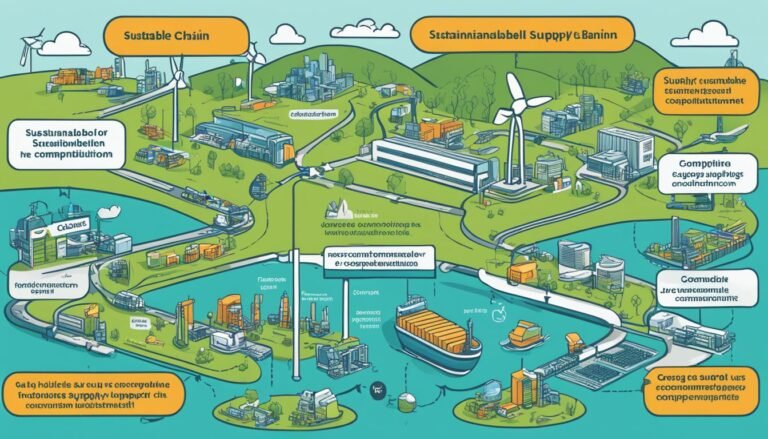Mezzanine Financing Solutions in Corporate Expansion
Did you know mezzanine financing is crucial for corporate growth? It’s a less common way to get capital for expansion. Many companies use it when they want to grow or buy other businesses.
This financing is a mix of debt and equity that benefits companies and investors. It fills a gap, giving companies more capital. This allows them to manage their debt and equity better. Mezzanine financing is flexible and can lead to high returns, which is why business leaders like it.
Key Takeaways:
- Mezzanine financing is a hybrid form of debt and equity financing used by established companies for expansion and growth initiatives.
- It offers increased capital, improved debt-to-equity ratio, and greater flexibility compared to traditional corporate debt.
- Mezzanine financing can be structured as subordinated debt or preferred equity, with higher interest rates than senior debt but less dilution to the company’s equity.
- It is subject to being replaced by lower interest financing if market rates drop significantly.
- Mezzanine financing is a key solution for powering corporate expansion and driving business growth.
What is Mezzanine Financing?
Mezzanine financing is a mix of debt and equity. It offers companies a flexible way to get funds. It fills the gap between traditional debt and equity. Moreover, lenders can change the debt to company equity if needed.
This financing is perfect for big projects or buying other companies. If a company goes bankrupt, mezzanine financing gets priority. It’s riskier than normal debt but less so than equity. It’s mainly for growing companies, not new ones or small startups.
Mezzanine loans sometimes have extra options like warrants. These options make the loan more valuable. They give more freedom to borrowers and lenders alike.
“Mezzanine financing offers companies the benefits of both debt and equity, making it an attractive option for corporate expansion and growth.”
Mezzanine financing is used in scenarios like:
- Acquisitions: It helps companies buy other companies by providing needed funds.
- Buyouts: It aids in both management and leveraged buyouts. This helps a company’s management or an outsider buy the company.
- Venture capital: Venture capital firms use it to give money to growing companies that have already started raising funds.
Overall, mezzanine financing gives companies more ways to raise funds. It’s key for corporate growth and expansion.
How Mezzanine Financing Works
Mezzanine financing is key for companies looking for money. It’s riskier but gives higher returns than other types. Businesses see it as mixing costly debt with cheaper equity, making it unique.
This financing type lets companies get more capital and boost their equity returns. It’s great for growing or buying other businesses. Long-term investors often go for it, helping strengthen a company’s finance.
One big thing about mezzanine financing is it only needs interest payments first. This gives companies more cash to grow and operate. Still, it must be planned well to balance the lender’s and borrower’s needs.
When structuring mezzanine financing, each business’s needs must be considered. The structure changes based on available capital, interest rates, and how much risk a business can take.
Key Considerations in Mezzanine Financing Structuring
- Senior Debt: Sits between senior debt and equity, bringing higher returns than the former but cheaper than the latter.
- Interest Rates: Has higher rates than senior debt due to higher risks.
- Capital Availability: Gives companies extra money for growth or to buy others.
- Interest Payments: Requires only paying interest at first, freeing up more money.
- Structuring: Needs careful planning to fit both lender’s and borrower’s requirements.
Mezzanine financing is a flexible way to get funds for expanding. Knowing how it works helps businesses plan better. It’s crucial to have the right financial advice to navigate its complexities successfully.
Mezzanine Financing Structure
Mezzanine financing is key for a company’s funding, sitting between senior debt and common stock. It helps businesses raise capital for growth or buying other companies.
Mezzanine financing comes in forms like subordinated debt and preferred equity. Subordinated debt is unsecured and falls below senior loans. It doesn’t have collateral backing it.
Preferred equity is a form where investors get a share in the company, much like owning stock. It comes after mortgage loans and mezzanine loans in priority.
Mezzanine financing can either be secured or not. Subordinated debt often doesn’t need specific collateral. This lets companies freely use the funds for various needs.
The interest rates for mezzanine financing can be stable or change over time. This flexibility helps companies manage their finances better. It fits well within their funding structure.
With mezzanine financing, companies don’t have to pay off the principal regularly. Instead, they can make payments monthly or when the loan matures, as per their agreement.
| Mezzanine Financing Structure | Characteristics |
|---|---|
| Subordinated Debt | Unsecured, ranks below senior loans, no collateral requirements |
| Preferred Equity | Equity investment, subordinate to mortgage loans and mezzanine loans |
| Interest Rates | Partially fixed or variable, aligned with cash flows and capital structure |
| Repayment | Monthly debt service payments or at maturity |
Mezzanine financing offers a flexible and customizable way for companies to structure their capital. It’s a great choice for businesses wanting to expand, buy other companies, or pursue new projects.
Advantages of Mezzanine Financing
Mezzanine financing is great for both entrepreneurs and investors. It’s a flexible and attractive way to get capital. Here are the main perks:
- Increased Capital: It gives entrepreneurs extra cash. This can help grow their business or buy other companies.
- Preserved Equity and Control: With mezzanine financing, owners keep more of their company. They don’t have to give away as much ownership to get funds.
- Improved Debt-to-Equity Ratio: It makes a company look better to lenders or buyers. Having more mezzanine debt shows financial strength.
- Flexibility: It’s more flexible than other debts. There’s no need for specific collateral. Plus, payments can be delayed.
- Higher Returns: Investors can make more money. Mezzanine financing has higher interest rates and the chance for equity gains.
- Portfolio Diversification: Investors can spread their risk by getting into debt and equity. This can lead to better returns.
- Exit Strategy: It can fit with a company’s plans to sell later. Investors might turn their debt into equity and profit more.
Mezzanine financing benefits both companies wanting to grow and investors seeking profits. The perks include more capital, owning more of the company, looking better financially, having payment flexibility, earning more, diversifying investment risks, and fitting with future sale plans. It’s a valuable choice for expanding businesses.
Check the table below for a quick look at mezzanine financing’s advantages:
| Advantages | Description |
|---|---|
| Increased Capital | Access additional funds for growth projects or acquisitions. |
| Preserved Equity and Control | Maintain ownership and control over the company. |
| Improved Debt-to-Equity Ratio | Enhance financial attractiveness to senior lenders or buyers. |
| Flexibility | Flexible repayment terms and collateral requirements. |
| Higher Returns | Attractive returns through higher interest rates and equity upside potential. |
| Portfolio Diversification | Participate in both debt and equity markets for risk mitigation and enhanced returns. |
| Exit Strategy | Align the financing with the company’s exit plans. |
Disadvantages of Mezzanine Financing
Mezzanine financing has its perks but comes with downsides and challenges. Entrepreneurs and investors need to think about these carefully.
Higher Costs and Risks
Mezzanine financing is pricier and riskier than senior debt. It has higher interest rates and fees. This ups the cost for entrepreneurs.
There’s also a risk of defaults or dilution. These can hurt the company’s financial health a lot.
Complex Negotiation and Structure
Negotiating and creating a mezzanine financing deal can get complicated. With so many parties and conditions, finding a good agreement is tough.
Sacrificing Control and Upside Potential
Mezzanine financing might make entrepreneurs give up some control and future gains. If the deal turns into equity, entrepreneurs could lose ownership and influence.
Higher Risk for Investors
Investors take on more risk with mezzanine financing than with conventional debt. The financing is unsecured without any collateral.
Returns may come slowly, and there’s a risk of losing money if the company goes bankrupt.
While mezzanine financing offers advantages, it’s crucial to weigh the costs, risks, and drawbacks carefully. Make sure it’s the right decision for you.
| Disadvantages of Mezzanine Financing | Explanation |
|---|---|
| Higher Costs and Risks | Mezzanine financing carries higher interest rates and fees, increasing the overall cost and posing financial risks. |
| Complex Negotiation and Structure | Negotiating and structuring mezzanine financing can be challenging due to the involvement of multiple parties and conditions. |
| Sacrificing Control and Upside Potential | Mezzanine financing may require entrepreneurs to surrender some control and potential upside due to potential equity conversion. |
| Higher Risk for Investors | Investors face higher risk due to the unsecured nature of mezzanine financing and potential loss of capital in case of company bankruptcy. |
How to Negotiate Mezzanine Financing
Entrepreneurs must be prepared with the right information to get good mezzanine financing terms. Here are important steps:
- Develop an impressive business plan: Your business plan should be solid, showing your company’s growth and financial future. It’s your chance to show your expertise and get lenders interested.
- Conduct a thorough valuation analysis: Lenders will check your company’s value and its potential to grow. Give them a detailed valuation to show what they can gain from investing in you.
- Identify suitable mezzanine lenders: Find lenders who know your industry and have market experience. Choose those who understand your business’s challenges and opportunities.
- Create a compelling pitch: Make a pitch that stands out, showing how your company can beat competitors and grow. Explain why mezzanine financing fits your needs and why lenders should join you.
- Negotiate key terms: Be ready to talk about important details like interest rates, loan duration, and payment plans. Aim for terms that meet your business goals and financial ability.
To get mezzanine financing, know your business’s financial health, potential to grow, and what risks you can handle. By making a strong argument and addressing lenders’ concerns, you’re more likely to get the terms you want and the funding your business needs to grow.
Sample Terms to Consider:
Below is a table with key terms you can discuss when getting mezzanine financing:
| Key Terms | Description |
|---|---|
| Interest Rate | The rate at which interest is charged on the mezzanine loan. |
| Maturity | The length of time until the loan must be fully repaid. |
| Fees | Various fees associated with the mezzanine financing, such as origination fees, closing fees, and monitoring fees. |
| Conversion Rights | The terms under which the mezzanine lender can convert their debt into equity ownership in your company. |
| Covenants | Conditions or requirements that the borrower must fulfill during the loan period, such as maintaining a certain financial ratio or limiting certain actions. |
Consider and negotiate these terms to make the financing work best for your business. With the right approach, you and your lender can both benefit.
How to Structure Mezzanine Financing
Mezzanine financing offers flexible, tailored solutions for companies. It helps them get capital for expansion or acquisitions. This financing usually involves subordinated debt, preferred equity, or both. Let’s look into how to structure it effectively:
Subordinated Debt
Subordinated debt is a key part of mezzanine financing. It falls below senior debt when it’s time to get repaid. Normally, it doesn’t have collateral and carries higher interest rates than senior debt. The higher interest compensates lenders for their increased risk.
Preferred Equity
Another way to structure mezzanine financing is with preferred equity. This means investing equity in a company owning property. Preferred equity gives holders a repayment and dividend priority over common shareholders. It lets investors gain from the company’s growth.
Interest Rates
Mezzanine financing comes with higher interest rates than senior debt. This is to make up for more risk. Rates can be between 12% to 20% yearly. They vary based on the borrower’s creditworthiness and market conditions.
Repayment Options
There are flexible repayment options with mezzanine financing. Options include cash, deferred, or accrued payments. Repayment terms adapt to the business’s cash flow and financial needs.
Fees
It’s crucial to mind the fees in mezzanine financing. Fees might be for origination, commitment, closing, monitoring, and exit. The exact fees depend on the lender and the deal’s terms.
Warrants and Conversion Rights
Mezzanine financing often comes with warrants or conversion rights. These let investors turn their debt or preferred equity into common equity. This option can improve investors’ gains, linking their interests with the company’s success.
Covenants
Covenants set financial or operational boundaries in a mezzanine financing agreement. They might regulate financial ratios or limit additional debt. Covenants safeguard the lender’s interests and the business’s financial well-being.
Choosing the right structure for mezzanine financing needs careful thought. Companies must consider their financial situation, risk tolerance, and lender’s terms. Knowing the different parts and options helps businesses find the best financing structure.
Mezzanine Financing Rate of Return
Mezzanine financing is great for investors looking for big wins. It offers multiple ways to earn back money. These include:
- Cash interest: Investors get paid regularly, based on how much they’ve invested. It’s a consistent way to make money over time.
- Payment in kind (PIK) interest: This interest gets added to what you initially invested and is paid at the end. It helps investors earn more.
- Ownership: Investing in mezzanine financing might let investors own a part of the company. If the company does well, this can lead to big gains.
- Participation payouts: If the company hits certain goals, like sales targets, investors can earn extra money. It’s a bonus for the company doing well.
Mezzanine financing also includes a fee for the lender when the deal is done. This fee is for their work in creating the deal.
This mix of cash interest, PIK interest, owning a part of the company, and bonus payouts make mezzanine financing appealing. It’s a good choice for those seeking investments with high returns.
| Source of Return | Description |
|---|---|
| Cash Interest | Periodic payments based on outstanding mezzanine funding balance |
| PIK Interest | Interest added to principal sum and paid at maturity |
| Ownership | Equity conversion or warrants providing ownership in the company |
| Participation Payouts | Payouts based on company’s performance metrics |
| Arrangement Fee | Fee paid upon closing the mezzanine financing transaction |
Benefits and Limitations of Mezzanine Financing
Mezzanine financing is great for businesses looking to grow. It lets them get more money without giving up much control. This way, owners keep more of their company while expanding.
It also makes a company look better to other lenders or those interested in buying. By using mezzanine financing, a business can depend less on traditional loans. This creates a healthier mix of debt and ownership.
Investors like mezzanine financing too. It offers higher interest rates than normal debt, meaning they could make more money.
But mezzanine financing isn’t perfect. One big issue is that owners might lose some control. If investors choose to turn their debt into shares, the original owners will own less of the company.
There’s also the risk of not being able to pay back the loan. If a company can’t meet its debt obligations, those who invested could lose their money.
Mezzanine financing needs patience as well. Returns on the investment might take a while to show up. Investors should think about how long they’re willing to wait.
To sum up, mezzanine financing has lots of pluses, like more money and maintaining control. Yet, these benefits come with downsides, such as the risk of losing control and the wait for returns. Both entrepreneurs and investors should weigh these factors carefully.
Benefits of Mezzanine Financing:
- Increased capital without significant dilution of ownership/control
- Improved debt-to-equity ratio
- Flexibility in pursuing growth projects and acquisitions
- Potential for attractive equity returns
Limitations of Mezzanine Financing:
- Potential loss of control for entrepreneurs
- Risk of default or failure to meet repayment obligations
- Longer time-period for returns to materialize
Comparison of Mezzanine Financing Benefits and Limitations
| Benefits | Limitations |
|---|---|
| Increased capital | Potential loss of control |
| Improved debt-to-equity ratio | Risk of default |
| Flexibility in pursuing growth projects and acquisitions | Longer time-period for returns |
| Potential for attractive equity returns |
Conclusion
Mezzanine financing solutions offer big opportunities for companies wanting to grow. This type of financing mixes debt and equity, making it a flexible option. It helps bridge the gap between traditional loans and sharing ownership.
Entrepreneurs benefit from accessing more capital and bettering their debt-to-equity ratio. This flexibility boosts their financial operations.
Investors also get good deals from mezzanine financing. They look forward to higher returns and some ownership. But, it’s key to remember that mezzanine financing has its challenges. The costs and risks are higher and need careful thinking during deals.
In conclusion, mezzanine financing is a good choice for expanding companies. It falls between debt and sharing ownership. Despite the need to watch out for costs and risks, it’s a powerful way to grow. Businesses can get the money they need, better their finances, and reach their goals.








